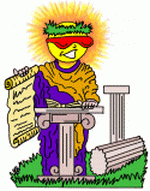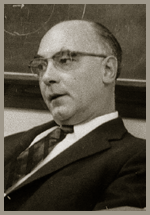Short history of antimatter

The beginning of the twentieth century was a particularly active period for physics.
In 1905 Albert Einstein proposed the theory of
Special Relativity![]() and Werner Heisenberg invented the theory of
Quantum Mechanics
and Werner Heisenberg invented the theory of
Quantum Mechanics![]() , but
this last theory was not relativistic.
, but
this last theory was not relativistic.
In 1928 the British physicist
Paul Dirac
solved this
problem by proposing an equation that combined Quantum Mechanics with
special relativity. But this equation seemed to have a problem: it foresaw one
electron![]() with positive energy and one with negative energy. But
in classical theories the energy of a particle has to be always positive. Then
Dirac hypothesized that all states with negative energy were occupied, and that
the transition of one particle with negative energy to positive energy lead to
the "creation" of a pair of particles: the particle with positive energy and
the hole left in the states with negative energies, which he referred to as an
antiparticle.
with positive energy and one with negative energy. But
in classical theories the energy of a particle has to be always positive. Then
Dirac hypothesized that all states with negative energy were occupied, and that
the transition of one particle with negative energy to positive energy lead to
the "creation" of a pair of particles: the particle with positive energy and
the hole left in the states with negative energies, which he referred to as an
antiparticle.
Later Dirac asked himself what the antiparticle of
the electron could be and he slowly came up with the idea that to any particle corresponded an
antiparticle![]() , with the same mass, but opposite
electric charge
, with the same mass, but opposite
electric charge![]() . In particular,
the partner of the electron is the antielectron, identical to the
electron but with a positive charge. In his Nobel Lecture Dirac speculated on the
possible existence of a new Universe, made of antimatter!
. In particular,
the partner of the electron is the antielectron, identical to the
electron but with a positive charge. In his Nobel Lecture Dirac speculated on the
possible existence of a new Universe, made of antimatter!
But physics is an experimental science and all theoretical predictions have to be verified by experiments; in other words, we should observe the antielectron experimentally.
 |
| Fig 2: Carl D. Anderson, Nobel Prize for Physics (1936). |
In 1932 the
American physicist
Carl David Anderson observed in
Cosmic Rays![]() a particle which behaved like an electron, but which had a positive charge: he
had discovered the first antiparticle, the antielectron, also called a
positron.
a particle which behaved like an electron, but which had a positive charge: he
had discovered the first antiparticle, the antielectron, also called a
positron.
In order to discover the antiproton,
scientists had to wait
for the new powerful particle accelerators, which could accelerate protons or
electrons to very high energies. In the 50's a new accelerator in Berkeley,
California reached energies sufficient to produce antiprotons and
antineutrons, which were observed with sophisticated equipment.
In the following years new accelerators at CERN, Geneva,
and Brookhaven, USA, made possible the production and observation of the antideuteron.
Later, even higher energy accelerators at Serpukhov, Soviet Union, and at CERN
allowed scientists to produce and observe antihelium 3 and antitritium.
Recently, anti-atoms of anti-hydrogen (anti-H=anti-p + e+) were produced at CERN decelerating antiprotons and antielectrons kept trapped in a vacuum via magnetic fields. It is more difficult to trap anti-hydrogen atoms because they are neutral: most of them hit the walls of the trapping chamber where they annihilate with the ordinary atoms of normal matter.